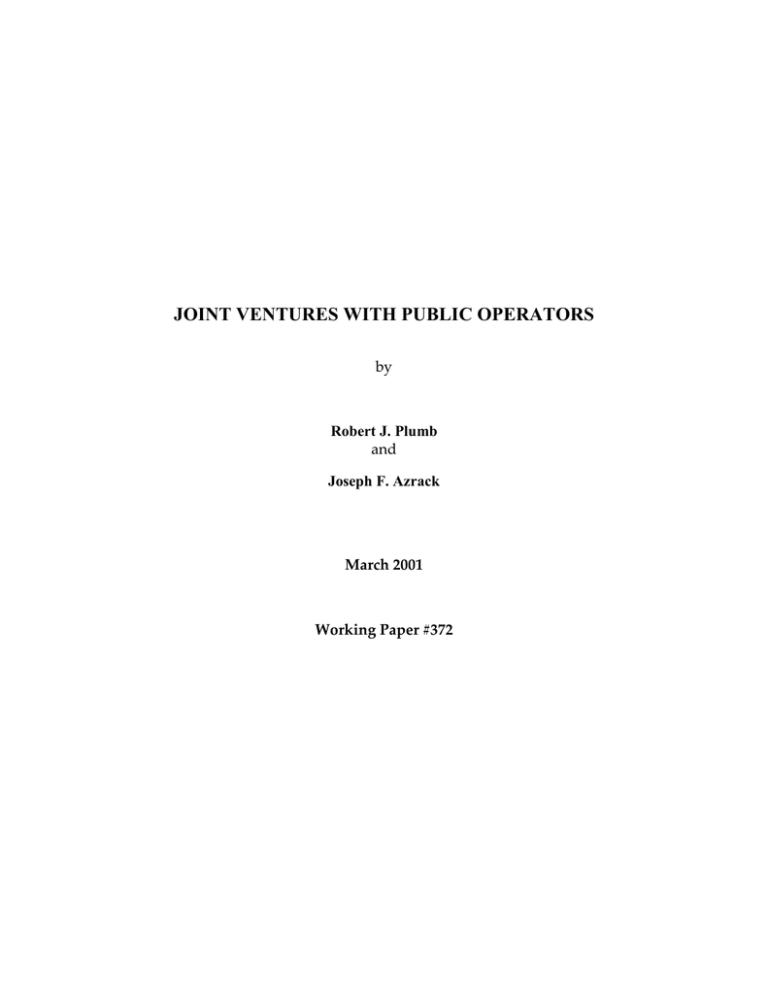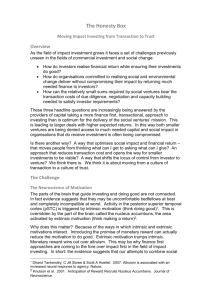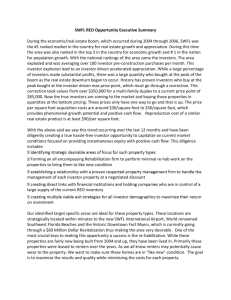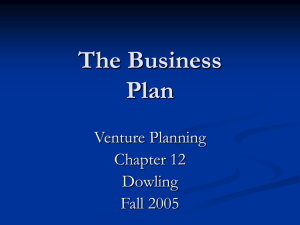JOINT VENTURES WITH PUBLIC OPERATORS by and
advertisement

JOINT VENTURES WITH PUBLIC OPERATORS by Robert J. Plumb and Joseph F. Azrack March 2001 Working Paper #372 By the mid-1990s, the U.S. real estate markets began to emerge from the deep recession that had gripped the industry in the early part of the decade. Buoyed by a strong and sustained economic boom, demand for space blossomed in virtually all U.S. markets, absorbing much of the overhanging supply glut that had marked the industry’s nadir. Accompanying this rebound was a rapid change in the way that commercial real estate was held and capitalized. The clearest evidence of this change was the burgeoning growth of the real estate securities markets (debt and equity). Between 1992 and the end of 1997, the total equity capitalization of the REIT market grew from under $10 billion to almost $130 billion, while CMBS market capitalization increased from $40 billion to $180 billion. Armed with this new capital, REITs went on a property-buying spree, effectively shifting a substantial amount of equity ownership from the private market to the public market. By year-end 1999, publicly held entities owned approximately $250 billion of U.S. commercial real estate, up from less than $10 billion at the beginning of the decade. Beginning in mid-1998, investors' romance with the emerging public real estate markets ended. Through the end of 1997, REIT share prices had risen, on average faster than property prices, allowing many REITs to make acquisitions that added to shareholder value. A “virtuous cycle” developed in which rising share prices attracted new investors who provided more capital for more acquisitions, which led to further increases in share prices, which attracted more investors, and so on as the cycle repeated itself. During 1998, however, share prices fell while private market prices continued to rise. Earnings estimates that were built on grand assumptions for acquisition and development were quickly trimmed. Share prices contracted and REITs suddenly found themselves unable to issue new equity as shareholders revolted at the notion of issuing stock below the price at which they had bought. The “virtuous cycle” became a “vicious cycle” in which falling share prices made it harder for REITs to raise money to make the acquisitions necessary to achieve external growth objectives and attract new capital. The effort by some REITs to avoid this cycle opened opportunities for hybrid public/private investment, specifically the creation of private-market joint ventures between institutional investors and publicly held real estate companies, most of which operate as REITs. When REIT prices dropped roughly 20 percent from the peak levels of year-end 1997 and almost all companies were trading well below the price of their last equity issuance, REITs were unable to tap public equity to raise capital. Hemmed in by the pressure from analysts to keep debt levels low and by regulations that prevented REITs from retaining earnings, public operating companies found themselves in dire need of alternative sources of capital to finance their growth strategies (and, they hoped, boost their share prices). Debt as a percentage of total market cap rose only slightly between year-end 1998 and 1999, and actually decined through June 2000. Enter several large pension plan investors (and their investment advisors), who saw in the joint venture structure an opportunity to maintain an exposure to, directly held real estate, while securing many of the benefits associated with real estate securities such as integrated management, aligned interests and reduced staff management time. Moreover, with most REITs then trading at a substantial discount to their net asset values, investors saw the potential to use the joint venture as a way to acquire highquality properties at a lower basis than through direct investment. JOINT VENTURES The fortunes of the REIT market reversed dramatically during the first half of 2000, with REIT shares surging in the wake of a broader downturn among Wall Street’s technology darlings. Capital flows from institutional investors, driven by asset allocation as well as opportunistic investing, increased significantly. Investors, always seeking the next hot sector, quickly followed suit, reversing nearly two years of negative mutual fund flows from the sector. As a result, many REITs saw their share prices return to a level close to net asset value and, in some cases, rise above the previous high water mark of 1997. Despite this resurgence, very few companies have elected to return to the market with new equity offerings. During the first half of 2000, REITs raised only $650 million in secondary equity offerings and virtually all of this came in the form of preferred offerings. To put this in context, during 1997 REITs raised more than $26 billion in secondary offerings. Thus far, REIT investors have made it clear that while they enjoy the recovery in share prices, they do not, as yet, want REITs to return to the “growth for growth’s sake” mentality that dominated the market during 1996 and 1997. Rather, companies continue to be rewarded for “sticking to the their knitting” with respect to growing earnings from their existing portfolio and engaging only in value-adding acquisition and development opportunities. As a result, many companies continue to embrace joint venture relationships with institutional investors rather than face the vagaries of the issuance market. Changes have occurred in these relationships, however, as REITs have moved from a position of weakness during 1998 and 1999, to a position of strength. Deal terms that favored the institutional investor partner in 1998-99 have become more balanced. Analyst scrutiny of joint venture deals has improved steadily over the past several years and a REIT that “gives away the store” to a joint venture partner is likely to be punished severely by investors. In addition, as private real estate market moves towards being fully priced, joint ventures are becoming more oriented towards development activity. At the same time, the ability of REITs to sell full or partial ownership interests in their lower quality properties, either to joint venture partners or in the open market, has improved. We believe that today there generally exists an equilibrium between REITs and their joint venture partners, with neither side dominating the relationship. Rather, the best companies are developing long-term relationships with patient capital that to varying degrees, frees them from the volatile market for equity issuance. In this environment, joint venture structures continue to serve the needs of both institutional investors and public real estate operators. The types of companies that offer the best investment potential are those with several baseline characteristics: a strong and deep management team, preferably with significant personal interests in the company’s ownership; a well-developed, viable strategy for growing the company’s franchise; a capital structure that matches the strategy; a proven history of creatively accessing multiple sources of capital; proven success in strategy execution throughout propertyand capital-market cycles; and high credibility among analysts. Finally, we also generally prefer larger companies, which are more likely to have had experience with institutional investors and whose trading volume is sufficient to allow for a timely exit (assuming a conversion option). STRUCTURING THE JOINT VENTURE A joint venture between an institutional investor and a public operator is usually capitalized with the operator contributing one or more properties from its existing portfolio while the investor contributes cash. This may afford the investor an opportunity to pick attractive assets from among the operator’s holdings. However, this may involve difficult valuation challenges. Further, because the transfer of appreciated properties from the public company to another entity may be treated as a taxable event to the company, this option is most common when the properties to be transferred from the public company’s portfolio are newly acquired and have not substantially appreciated. Another alternative is to pursue an acquisition or development strategy with the operator. In this instance, the operator and the investor each will contribute cash to establish their relative joint venture interests. The investment program may be structured to be property-type and/or geographic-region specific. In this sense, joint ventures can be used as “completeness” investments to round out the institutional investor’s portfolio holdings. Further, the portfolio can be tailored to specific risk/return objectives. For example, the nature of the assets to be acquired can range from those with “core” characteristics (existing, operating assets, fully leased to credit tenants) to more valueadded opportunities (assets requiring some level of renovation, re-positioning or releasing, as well as selected new development). It is critical that the investor and the REIT operator share return objectives and clearly define criteria with respect to property type, asset quality, target markets, holding period and use of leverage. The most complicated part of structuring joint ventures with public operators is constructing an exit strategy. This is because the institutional investor and the public operator tend to have opposing objectives with respect to the ultimate disposition of an asset — the investor often wants to sell and realize gain while the operator prefers to operate the asset as part of its portfolio. There are several potential ways to bridge this divide. Provisions that give the investor the right to sell its interest to another investor, typically subject to a right of first offer on the part of the public operator, are common, as well as buy-sell provisions that may be exercised by either party after a certain date. While simple in theory, such provisions can be difficult to execute in practice, raising issues of divisibility of interests and valuation of partial interests. It is also important to structure such arrangements with an eye toward minimizing any adverse impact on the marketability of the asset. Another alternative — and one that is a unique advantage to joint ventures with public operators — is a conversion option that gives the investor the right to convert his interest in the venture into the stock of the public company. Such options can be structured at market or at a specified price. From the institutional investor’s standpoint, a market-rate option provides a potentially attractive exit strategy for what is clearly a private-market transaction. The fixed-price option, on the other hand, is appropriate when the goal is to make an investment in the company, as well as in the specific joint venture assets. On the positive side, conversion options provide an alternative exit strategy and the potential for enhanced total return (through share price appreciation). This approach also offers a possible solution to a very tricky problem: “re-casting” a private joint venture relationship when the objectives of the partners diverge over time. Through execution of the conversion option, the ownership interests of the joint venture partners become clearly divisible, and each party gains the benefits of full control over its interest, greater certainty of market pricing, and increased liquidity (provided the company has adequate float relative to the size of the investor’s interest). There are few, if any, negatives with respect to market-rate conversion options, which simply give both the buyer (the company) and the seller (the investor) an alternative currency (shares) with which to complete their transaction. However, weighing in against fixed-price conversion options are issues of valuation and complexity that may, ultimately, affect the likelihood of closing a joint venture with such provisions. Since property-to-stock conversions can add significant potential value to a transaction, the company will not enter into them without extensive negotiation relative to conversion terms. It is our experience that the documentation of conversion options significantly increases the time and cost of completing the overall agreement, thus decreasing the probability of a successful closing. Further, there are likely to be restrictions (at least in the short term) on a sale of the converted position. It is important to note that once a fixed-rate conversion option transaction is announced, both existing shareholders and analysts will evaluate the cost of the conversion option very carefully. Thus, even “winning” in the negotiation process can result in no net benefit to the investor. Before fighting hard for a fixed-rate conversion option, an investor should assess the share price performance and future fundamentals of companies that have executed comparable joint venture transactions. Thus, in considering whether the transaction should include a fixed-rate conversion option, the investor must carefully evaluate whether the investment characteristics of the stock are worth the additional effort necessary to negotiate what is effectively the issuance of a call option by the company. If the investor’s primary objective is to make private investments with skilled operators, this additional risk may not be not justified. Finally, when dealing with a public partner the institutional investor should remember that the operator’s first duty is to its shareholders (with the attendant responsibilities to the analyst community) and not its real estate partners. The operator will typically demand a contract to manage the joint venture assets for some minimum period of time, at a reasonable fee with appropriate exit mechanisms, in order to ensure that the company is perceived as either controlling the exit or being paid for “going away.” In return, the institutional investor should demand meaningful co-investment and a cap on management fees at the market rate. WHY NOT JUST BUY THE STOCK? From the perspective of the institutional investor, joint venturing with a capable, experienced public operating company offers a variety of benefits. First, and perhaps most importantly, this transaction is clearly viewed as real estate – it is handled by the institution’s real estate staff, applied toward meeting real estate allocation targets, and is viewed as adding the risk diversification benefits that are part of the institution’s broader investment strategy. Beyond this, there are several other critical benefits. First, efficiency; investing in a joint venture is an effective way to invest relatively large amounts of capital quickly and efficiently. Alignment of interests; public operating companies are internally managed by skilled professionals who generally will have substantial amounts of their own equity invested alongside that of their joint venture partners. This serves to align the economic interests of the operator with those of the investor. Where these interests diverge (with respect to the ultimate disposition of the portfolio), careful structuring can help to minimize the potential impact on investment performance. Diversification; investing alongside an operator in the acquisition or development of a pool of properties significantly reduces asset-specific risk and moves the investor towards exposure to the systematic risk of the real estate market as a whole. Partially offsetting this asset diversification benefit is the assumption of entity-level risk related to the management and franchise value of the company. However, provided the depth and quality of management are properly underwritten, the asset diversification benefit should outweigh the entity-level risk that is assumed. Lastly, specificity of assets; to the extent the investor puts its capital into an existing portfolio, the investment is made in specified assets, operated by managers whose capabilities are known. Even if the capital will be used to acquire or develop additional assets, the investor and operator will have agreed in advance on specific investment criteria that will clearly define each asset’s key attributes, such as property type, location, size, quality, leverage and anticipated return. SUMMARY Real estate is a capital-intensive industry, and access to institutional private capital likely will become increasingly important as the size of public operating companies continues to grow. Despite a dramatic turnaround in the REIT market this year, REITs remain cautious about secondary equity issuance. While this may change eventually if the recovery in share prices continues, REITs continue to look for longer-term capital relationships with institutional investors through mutually beneficial joint ventures. Overall, this has been a positive development for the sector. REITs have been able to pursue well thought out acquisition and development opportunities with their joint venture partners, while at the same paying heed to the more cautionary demands of their shareholder base that prefers to see companies continue to nurture the internal growth of their existing portfolios. Structured correctly, we believe that joint venture relationships between REITs and institutional investors can be a “win-win situation” for the sector and its myriad classes of investors. [Author bios: Robert J. Plumb is a Principal of AEW Capital Management and head of acquisitions for the firm’s direct investment group. Joseph F. Azrack is Chairman of AEW Capital Management, a real estate investment advisor managing institutional investments in over $9 billion of real estate.]






